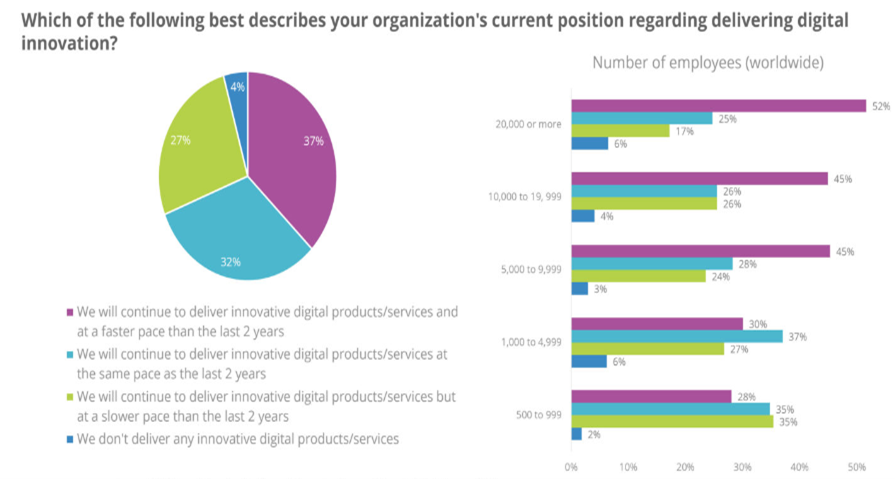Comments
- No comments found

The financial services industry is constantly evolving, and there are several key trends to watch out for in 2023.
Here are a few of the most important ones:
Digital transformation: Financial services companies will continue to invest in digital technology and transform traditional processes into digital ones, in order to improve efficiency, increase accessibility, and provide a better customer experience.
Increased regulation: With the growth of digital financial services, there will likely be increased regulation to ensure that these services are secure and to protect consumers' personal and financial data.
Growing use of blockchain: Blockchain technology is expected to play an increasingly important role in the financial services industry, particularly in areas such as cross-border payments, supply chain financing, and digital identity management.
Artificial intelligence and machine learning: Financial services companies will increasingly use AI and machine learning to automate processes, improve decision-making, and better understand their customers.
Rise of digital currencies: The adoption of digital currencies and blockchain-based payment systems is expected to continue to grow, offering new opportunities and challenges for the financial services industry.
Sustainability and ESG investing: As consumers become more conscious of environmental, social, and governance (ESG) issues, financial services companies are likely to focus more on sustainable investing and other ESG-focused initiatives.
Remote and hybrid work: The pandemic has accelerated the trend towards remote and hybrid work in the financial services industry, and this trend is expected to continue in 2023.
Overall, these trends demonstrate the need for financial services companies to adapt and evolve in order to stay relevant and meet the changing needs of customers in the digital age.
The Global Banking Summit, hosted by The Financial Times and The Banker is the standout annual international conference for industry leaders. This event shapes the conversations that drive banking forward, sharing knowledge on building business in a tough economic climate - especially as recession anxieties, evolving competition, compliance pressures and geopolitical tensions all rise. This forum is an enriching opportunity to be a part of the debate to inspire innovation in local and international markets in the year ahead. I was delighted to be invited to participate by Microsoft and the Financial Times.
The event brings together the holistic ecosystem of finance and banking leaders with incumbents and challengers, technology partners and regulatory organisations. This year’s focus on ‘Sustaining a Growth Mindset in Banking: Innovating for Consumer Needs’ could not be more timely. In this reflection, I highlight key themes around ESG; emergent technologies, especially cloud, partnerships, strategy and digital transformation; and place these in the context of the implications ahead for 2023. This has been shaped by sessions detailed in the ‘Additional Resources’ section at the bottom of this article, which are all available to view on demand here, as well as informed by my ongoing work with Microsoft across these areas.

ESG was first defined within the UN’s Global Compact’s whitepaper entitled Who Cares Wins - a document that strives to avoid the misunderstandings that derive from different interpretations of these terms - as ‘issues which have or could have a material impact on investment value’. Today the increased resonance and prominence of ESG is moving center stage across multiple verticals including financial services – indeed recent research by SAS found that 76% of banking executives surveyed believe the sector has an obligation to address societal issues.
However, this also reveals an ‘intention-action’ gap with 64% of respondents identifying that banking lags behind other verticals in advancing ESG goals. The discipline has found itself under pressure from different extremes of view with companies, regulators and assets managers ‘stuck in the middle’ and consumers often left confused. When you look at something as complex but critical as ESG, it is necessary to take a multi-lens and measurable approach to manage the risks while also growing its opportunity imperative.
This was a position echoed by Janet Jones, Client Director Financial Services at Microsoft in the event session How can banks continue digital transformation in a downturn? and supported by an enriching dialogue with Rishi Khosla, Co-founder and CEO of Oak North Credit Intelligence; Claire Calmejane, Chief Innovation Officer at SocieteGenerale; Andy Ellis, CEO Mettle and Head of Digital Assets at NatWest Group; and moderated by Liz Lumley, Deputy Editor of The Banker.
Janet highlighted how ESG has become such a prominent focus across consumer, employee and business leadership perspectives. It’s driving heightened expectations and the imperative for behavioral action by banks and the financial services industry more broadly. But as many organisations continue to develop and embed their own proprietary approaches this can culminate in a ‘patch-work’ of siloed impact - and can create complexity and misunderstanding.
This raises several questions: what declarations can consumers and other ecosystem partners rely on? What ESG reporting is needed, and can this be compared? How is investment going to be used and how will success be measured? Additionally, what skills are needed – and do we have them?
Emerging from this, related conversations and research, the need for standardization is clear, alongside ESG reporting that is consistent, comparable and holistic. Putting this into context, BCG recently highlighted an intention-action gap in this regard:
· 85% of organizations are concerned about reducing their greenhouse gas emissions
· 96% have set targets for reducing emissions in at least one scope
· 11% have cut their emissions in line with their ambitions over the past five years.
However, the application of data science, analytics and measurement can make a significant difference, with the use of AI reducing greenhouse gas emissions by up to 40%. Let’s now explore the impact of emergent technology adoption in the financial services space more broadly, and with particular attention to modernisation with cloud.
Digital technology is a deflationary force in an inflationary economy. It’s especially so in highly volatile sectors such as retail and the consumer goods industry when dealing with vectors of change including talent shortages, unstable supply chains, evolving expectations and behaviours, skills gaps and of course the impact of rising inflation. Indeed IDC research recently found that 69% of CFOs plan to increase their spend on digital capabilities through the recession period.

Success necessitates accelerating digital capabilities across every function in the organization. As Microsoft CEO and Chairman Satya Nadella described at the last Microsoft Inspire Conference, ‘the next 10 years won't be like the last 10 years’. This can be empowered by the 5 pillars of:
1. Migrate to the cloud - it all starts with infrastructure!
2. Empower your teams
3. Unify data and apply AI models
4. Embed collaborative business processes
5. Prioritize security by design
In the keynote interview by Craig Wellman, Managing Director, Financial Services at Microsoft the heart of Digital Perseverance emerges to be ‘as much about people and culture as much as it is about technology’. Indeed, as Craig explores, digital transformation is an always-on ‘… lifecycle choice that you must be continually investing in, skilling around, partner on, be open minded about, listening to [fintech competition, consumer expectations] and reflecting on how you have adopted digital capabilities – do you make full use of the capacity?’
Reflecting on the power of the ecosystem, a number of examples are worthy of note, commencing with the strategic ten-year partnership between Microsoft and the London Stock Exchange Group for next-generation data, analytics and cloud infrastructure solutions.
I was also impressed to see Microsoft collaborating with Trade Ledger, a leader in advancing digital approaches for working capital solutions for small businesses, enabling better ways to provide traditional products as well as leading on innovation like embedded lending. Support for organisations of all sizes is simply vital. There is excellent research that supports this: Working Capital Predictions 2023.
Back within the FT event itself, exploration around FinTech partnerships for innovation was a recurring dialogue. Set in the context that the global fintech market is forecast to grow by $277.22 billion during the period 2022-2027, accelerating at a CAGR of 20.5%. This is especially strong in fintech subsectors, notably climate fintech with investment up by x10 to $3.0B.
In the session How can banks continue digital transformation in a downturn? Janet Jones, Client Director Financial Services at Microsoft foregrounded the importance of the partner network. She specified the importance of the ‘marketplace’ which speeds up on-boarding processes due to the level of due diligence already completed, alongside industry specialisation, for example with partners Rewired Earth and Carbon Place in the ESG space. This is also reflected in Microsoft’s $1 billion pledge in funding over 4 years to invest in cutting-edge climate technologies and accelerate the implementation of extant climate solutions.
Also, to the fore remains the criticality of investment in experience from both consumer and employee perspectives. This is catalysed by changes in technology adoption, expectations and behaviours and thereby foregrounding ‘the economics’ of customer insights, experience, engagement, loyalty and employee retention. With almost 80% of consumers now using more than one channel to start to complete a transaction (Salesforce 2022) these interactions must be friction-free or in other words, feel integrated, seamless and consistent.
Putting this into context with an example relevant for insurance carriers and other financial institutions, you can learn more here about how Microsoft technologies including IVR, Azure Cognitive Services, D365 CRM and Contact Center capabilities align to modernize customer, agent, and employee experiences to enable the move beyond multichannel and omnichannel, right through to true ‘opti-channel’ enablement.

And finally, as discussed across the FT Summit, incumbent banks are increasingly abandoning legacy systems in order to provide a modern cloud offering to meet the evolving and personalised experience needs outlined - and also compete with the rise of the neobank. So what are the key challenges in ultimately achieving this? This was an area highlighted by Cal Corcoran, Vice President, Global Banking Lead at Microsoft in the session ‘Disruptech Stream: Fintech and Cloud Migration: Overcoming new barriers to the digital transformation’ with fellow industry experts.
Whilst the reasons for and ways into cloud will vary, the points Cal highlighted on strategy remain front of mind. These include the need to evaluate your path from ‘base camp to summit Everest’ or in other words, to extend beyond moving to the cloud, to transforming and gaining full value from that move! Rather than vertical slicing, the optimum approach is to build cloud horizontally so that all lines of business can consume in the way that works best for them – but still govern this holistically. It is important to stress that cloud can afford incremental change rather than ‘rip and replace’, as evidenced with NatWest Group’s successful use of Microsoft Dynamics. The imperative to constantly check-back on ‘the why’ of transformation is key – putting the business case at the front-end and value tracking across the lifecycle of the process and beyond. And with particular reference to incumbent banks, the ‘crawl, walk, run’ approach to cloud digital transformation is recommended:
Crawl: Primarily involving developers, sandbox testing, collaboration tooling
Walk: Set the right foundations including building a control plane – storage, databases
Run: Advanced use cases including AI and digital banks
Underpinning all of the above is the need to pay close attention to your people, not just your technology. You need to bring everyone with you, from Legal and Compliance to Professional and Citizen Developers, through to Marketing, Sales and HR – and that takes investment in skills such as EQ, not only technical subjects. In a market of increasing employee agency due to accelerating supply-demand gaps, banks are in competition with ‘big tech’ for talent, and access to skills uplift and reskilling opportunities has probably never mattered more. This affects onboarding, propensity to churn and, moreover, innovation outcomes.
Addressing this, the Financial Services Skills Commission (FSSC) is affording research and support in this very domain and Microsoft’s Get On 2021 campaign is set to help 1.5 million people in the UK build careers in technology and transition into digital skills careers by 2025. This is supported further still by skills resources such as Microsoft Learn – there are fantastic opportunities here to break down once traditional barriers to access.
To close, I will leave the final thought with Cal’s apt description of the holism that underpins digital transformation success – alongside your technology, education, process, communication and change management approach - this is ultimately a people proposition:
The people journey is the one to watch when it comes to digital transformation and specifically cloud…that means building people muscle…not just technical muscle.
Cal Corcoran, Vice President, Global Banking Lead, Microsoft
Dr. Sally Eaves is a highly experienced Chief Technology Officer, Professor in Advanced Technologies and a Global Strategic Advisor on Digital Transformation specialising in the application of emergent technologies, notably AI, FinTech, Blockchain & 5G disciplines, for business transformation and social impact at scale. An international Keynote Speaker and Author, Sally was an inaugural recipient of the Frontier Technology and Social Impact award, presented at the United Nations in 2018 and has been described as the ‘torchbearer for ethical tech’ founding Aspirational Futures to enhance inclusion, diversity and belonging in the technology space and beyond.
Leave your comments
Post comment as a guest